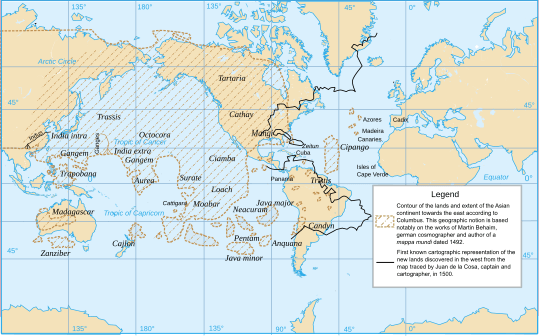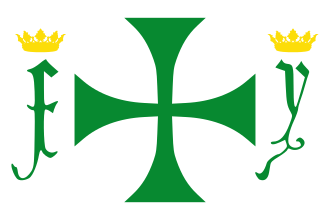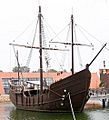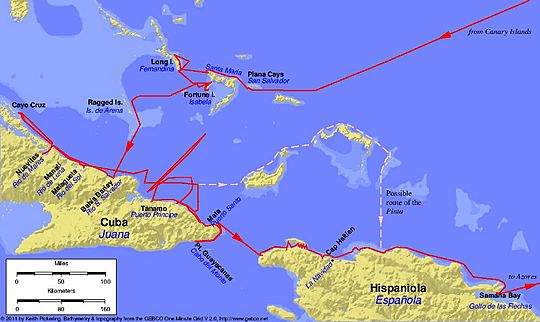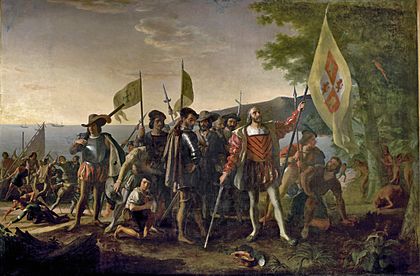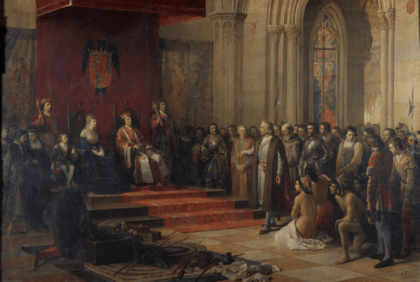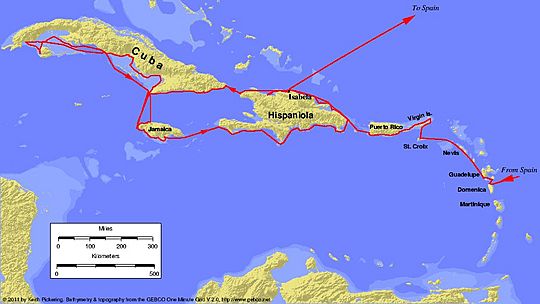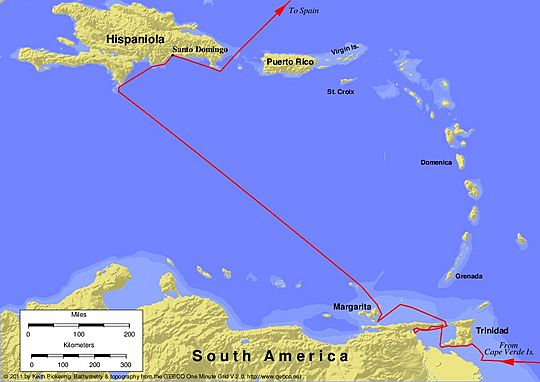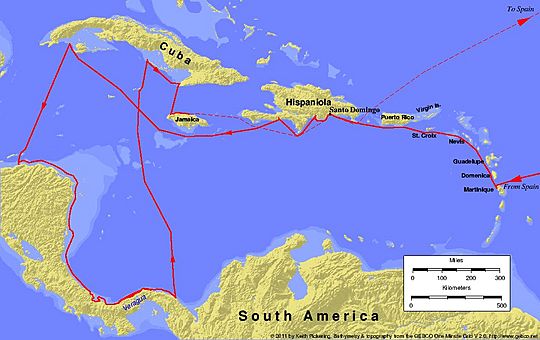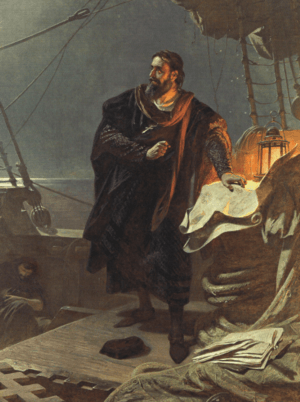Voyages of Christopher Columbus facts for kids
| Part of the Age of Discovery | |
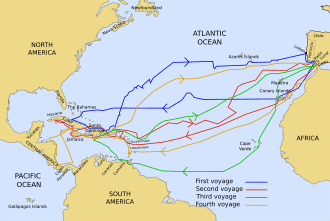
The four voyages of Columbus (conjectural)
|
|
| Date | 1492, 1493, 1498 & 1502 |
|---|---|
| Location | The Americas |
| Participants | Christopher Columbus and Castilian crew (among others) |
| Outcome | European rediscovery and colonization of the Americas |
Between 1492 and 1504, an Italian explorer named Christopher Columbus led four sea trips across the Atlantic Ocean for Spain. These trips led to Europeans learning about the Americas, which was a "New World" to them. This started a time called the Age of Discovery. During this period, Europeans began to settle in the Americas. There was also a big exchange of plants, animals, and diseases between the "Old World" (Europe, Asia, Africa) and the "New World." These events are often seen as the start of the modern era.
Columbus was born in Genoa, Italy. He was a navigator who sailed for the Crown of Castile (an old kingdom in Spain). He wanted to find a new way to reach the Indies by sailing west. The Indies were thought to be in East Asia, where valuable spices and goods came from. These goods were usually brought by difficult land routes. Columbus was partly inspired by the explorer Marco Polo. Columbus always believed he had reached Asia, even though he had found new lands. Because of this, the islands of the Caribbean are still sometimes called the West Indies.
When Columbus arrived, the Americas were home to many Indigenous peoples. Soon after Europeans arrived, diseases like smallpox spread. These diseases greatly harmed the native populations. Columbus's actions began the Spanish conquest of the Americas. He treated the native people harshly and forced many into labor.
Columbus died in 1506. The next year, the new continents were named "America" after another explorer, Amerigo Vespucci. Vespucci realized these lands were a unique landmass, not part of Asia. The search for a western route to Asia was finally completed in 1521. Another Spanish trip, the Magellan expedition, sailed across the Pacific Ocean. They reached Southeast Asia and then returned to Europe, completing the first trip around the world.
Contents
Why did Columbus sail west?
For a long time, Europeans thought that one big ocean surrounded Europe and Asia. However, Norse explorers had already visited and settled parts of North America around 986 AD. Their settlements in North America mostly ended by the early 1400s.
Until the mid-1400s, Europe had a safe land route to China and India. These places provided valuable goods like silk and spices. This route was safe because of the Mongol Empire, a time known as the Pax Mongolica (Mongol Peace). But in 1453, the Ottoman Empire took over Constantinople. This made the land route to Asia, the Silk Road, much harder for Christian traders to use.
Portugal became the main European country looking for new sea trade routes. The neighboring kingdom of Castile (which later became part of Spain) was slower to explore the Atlantic. This was because they were busy fighting to take back land from the Moors in a period called the Reconquista. This changed in the late 1400s. Queen Isabella I of Castile and King Ferdinand II of Aragon married in 1469. They were known as the Catholic Monarchs of Spain. In 1492, they finished the Reconquista by conquering the Moorish kingdom of Granada.
The new Spanish Empire decided to pay for Columbus's trip. They hoped to find new trade routes. They also wanted to avoid Portugal's control over trade routes around Africa and in the Indian Ocean.
Columbus's plan for sailing
By the 1480s, Christopher Columbus and his brother Bartholomew had a plan. They wanted to reach the Indies (which meant all of southern and eastern Asia back then). They planned to sail directly west across the Atlantic Ocean, which they called the "Ocean Sea." Around 1481, a map from an Italian mapmaker named Paolo dal Pozzo Toscanelli showed such a route. It only showed a mythical island called Antillia in the middle.
Some people mistakenly believe that Europeans thought the Earth was flat during Columbus's time. This idea became popular much later. In reality, most educated people knew the Earth was round. Ancient Greek scientists had already figured this out. Columbus's navigation relied on knowing the Earth was round.
How big was the Earth?
Ancient Greek scholars like Eratosthenes had measured the Earth's size quite accurately. Scholars and sailors knew how to calculate its diameter. Columbus, however, made a mistake. He thought the Earth was much smaller than it actually was. He believed Asia could be reached easily by sailing west across the Atlantic. Most scholars of his time agreed with Ptolemy's correct idea that the known landmasses (Europe, Asia, and Africa) covered 180 degrees of the Earth. They disagreed with Columbus's claim that the Earth was much smaller.

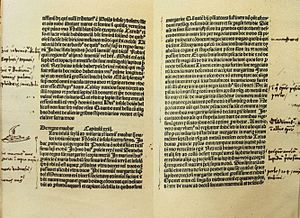
Columbus used incorrect calculations. He thought the distance from the Canary Islands to Japan was only about 2,400 nautical miles. This was only about 23% of the actual distance.
Using the winds
Another important part of Columbus's voyages was using the trade winds. He planned to sail first to the Canary Islands. From there, he would use the northeast trade winds to go west. To return to Spain, he would need to sail against the wind for a while. Then, he would catch the "westerlies" that blow eastward across the North Atlantic to Europe.
The Portuguese had already used this sailing technique, calling it the volta do mar (turn of the sea). Columbus's understanding of Atlantic wind patterns was not perfect on his first trip. By sailing directly west from the Canary Islands during hurricane season, he risked getting stuck or running into a tropical storm. Luckily, he avoided both.
Getting money for the trip
Around 1484, Columbus presented his plan to King John II of Portugal. The king's experts rejected it. They said Columbus's estimate of 2,400 nautical miles was about four times too low, which was correct.
In 1486, Columbus met with the Catholic Monarchs of Spain, Isabella and Ferdinand. He showed them his plans. They sent his ideas to a committee. This committee also decided that Columbus had greatly underestimated the distance to Asia. They thought the idea was not practical. To keep Columbus from taking his ideas to other countries, the monarchs gave him a small allowance.
In 1488, Columbus tried again with the Portuguese court. This also failed. Soon after, Bartolomeu Dias returned to Portugal. He had successfully sailed around the southern tip of Africa. With an eastern sea route now controlled by Portugal, they were no longer interested in a western route to Asia.
In May 1489, Isabella sent Columbus more money. The same year, the Catholic Monarchs gave him a letter. This letter ordered all cities and towns in their kingdom to give him food and lodging for free.
As Queen Isabella's forces were close to winning against the Moorish Emirate of Granada, Columbus was called back to the Spanish court. He waited until January 1492, when the monarchs conquered Granada. A group led by Isabella's confessor, Hernando de Talavera, again found Columbus's plan to reach the Indies unbelievable. Columbus was about to leave for France. But King Ferdinand stepped in. He sent people to convince the queen. Finally, Isabella was persuaded by her clerk, Luis de Santángel. Santángel argued that Columbus might take his ideas elsewhere. He also offered to help arrange the funding. Isabella then sent a guard to find Columbus, who had already traveled several kilometers away.
In April 1492, an agreement called the "Capitulations of Santa Fe" was made. Columbus was promised the title "Admiral of the Ocean Sea." He would also be made viceroy and governor of any new lands claimed for Spain. He would also receive ten percent of all money from these new lands forever if he succeeded. He could also suggest three people for any job in the new lands, and the monarchs would choose one. These terms were very generous. But, as his son later wrote, the monarchs were not sure he would return.
Columbus's First Voyage (1492–1493)
For his first trip west to find a shorter way to Asia, Columbus and his crew used three ships. The largest was a carrack called the Santa María. It was owned and captained by Juan de la Cosa and under Columbus's direct command. The other two were smaller caravels. One was called the Pinta ('painted one'). The other, the Santa Clara, was nicknamed the Niña ('girl'). The Pinta and the Niña were sailed by the Pinzón brothers. On August 3, 1492, Columbus left Palos de la Frontera, Spain.
|
The Niña, the Pinta, and the Santa María |
|
Three days into the trip, on August 6, 1492, the rudder of the Pinta broke. The crew managed to fix it temporarily. They reached the Canary Islands on August 9. The Pinta got a new rudder on Gran Canaria. By September 2, the ships met at La Gomera. There, the Niña's sails were changed to standard square sails. They got their final supplies. On September 6, the ships left San Sebastián de La Gomera for a five-week journey across the Atlantic.
On September 13, 1492, Columbus noticed that his compass needle no longer pointed to the North Star. This phenomenon, called magnetic declination, was already known.
Finding the Americas
After 29 days without seeing land, on October 7, 1492, the crew saw many birds. Columbus changed course to follow them.
On October 11, Columbus changed the ships' direction to due west. He believed land was very close. Around 10:00 PM, Columbus thought he saw a light "like a little wax candle rising and falling." Four hours later, a sailor named Rodrigo de Triana on the Pinta spotted land. He immediately shouted to the crew. The ship's captain confirmed it and told Columbus. Columbus later claimed he saw the light first, earning a reward.
Columbus named this island San Salvador. It is in the present-day Bahamas. The local people had named it Guanahani. Columbus wrote about the natives he met on October 12, 1492. He noted their gold ear ornaments. He took some of them as prisoners and made them guide him to the gold. Columbus also observed that their simple weapons made them easy to conquer.
Columbus called the native people indios (Spanish for Indians). He mistakenly thought he had reached the East Indies. The islands of the Caribbean are still called the West Indies because of this mistake. Columbus first met the Lucayan, Taíno, and Arawak peoples.
Columbus explored the northeast coast of Cuba, landing on October 28, 1492. He also explored the northwestern coast of Hispaniola (today's Haiti) by December 5, 1492. Here, the Santa Maria ran aground on Christmas Day, December 25, 1492. It had to be left behind. Columbus was welcomed by the native chief Guacanagari. He allowed Columbus to leave some of his men behind. Columbus left 39 men and started a settlement called La Navidad. He continued sailing along Hispaniola's northern coast with one ship. He met Pinzón and the Pinta on January 6.
On January 13, 1493, Columbus made his last stop in the Americas for this trip. It was in the Bay of Rincón in Hispaniola. There, he met the Ciguayos. They were the only natives who fought back during his first voyage. Because of this, he called the area the Bay of Arrows. On January 16, 1493, the journey home began.
First return to Spain
On the way back to Spain, the Niña and Pinta faced a terrible storm. They lost contact with each other on February 13. On February 15, land was spotted. It was the Azores. On February 17, the Niña anchored at Santa Maria Island. Columbus sent half his crew to the island to fulfill a vow they had made during the storm. However, the islanders captured them. The island's captain, João de Castanheira, thought they were pirates. After two days, Castanheira released the prisoners.
Leaving Santa Maria in the Azores on February 23, Columbus headed for Spain. But another storm forced him into Lisbon, Portugal. He anchored on March 4, 1493. He learned that a fleet of 100 ships had been lost in the storm. Amazingly, both the Niña and the Pinta had survived. Columbus met with King John II of Portugal. The king believed Columbus's voyage might break an earlier treaty between Portugal and Spain. After more than a week in Portugal, Columbus sailed for Spain. He arrived back in Palos on March 15, 1493. Later, he met with Ferdinand and Isabella in Barcelona to share what he had found.
Columbus showed the monarchs what he had brought back. This included small gold samples, pearls, native gold jewelry, flowers, and a hammock. He gave them some gold, jewelry, and pearls. He also brought the unknown tobacco plant, the pineapple fruit, and the turkey. He did not bring the valuable East Indies spices like black pepper.
Columbus wrote to the monarchs, suggesting he could force some native people to work. He described the island of Hispaniola as being off the coast of China. He highlighted the land's potential riches and that the natives seemed willing to become Christians. His descriptions were very positive, especially about the amount of gold:
Hispaniola is a miracle. Mountains and hills, plains and pastures, are both fertile and beautiful ... the harbors are unbelievably good and there are many wide rivers of which the majority contain gold. ... There are many spices, and great mines of gold and other metals...
When Columbus returned, most people, including the monarchs and Pope Alexander VI, believed he had reached the East Indies. However, a historian named Peter Martyr d'Anghiera described Columbus as the discoverer of a Novi Orbis ('New Globe'). The Pope issued several official orders. These orders decided how Spain and Portugal would settle and divide the new lands. One order, Inter caetera, issued on May 4, 1493, divided the world outside Europe between Spain and Portugal. Spain received all the land Columbus discovered. The 1494 Treaty of Tordesillas later moved this dividing line further west.
Columbus's Second Voyage (1493–1496)
The main goal of the second voyage was to teach the native people about Christianity. Before Columbus left Spain, the monarchs told him to be friendly and kind to the natives. He sailed from Cádiz, Spain, on September 25, 1493.
The fleet for this second trip was much larger. It had two large ships and 15 smaller ones. The Niña also returned for this trip. The expedition also built the first ship in the Americas, called the Santa Cruz.
Exploring the Caribbean
On November 3, 1493, Columbus landed on an island he named Dominica. The same day, he landed at Marie-Galante. He then sailed past other islands, including Guadeloupe, which he explored for several days. He likely sailed north, seeing and naming many islands like Montserrat, Antigua, Saint Martin, and Saint Croix. He also named the Virgin Islands.
The fleet continued to the larger islands. They landed on the island of San Juan Bautista, which is today Puerto Rico, on November 19, 1493.
Hispaniola and Jamaica
On November 22, Columbus sailed from Puerto Rico to Hispaniola. The next morning, a native person taken during the first voyage was returned to Samaná Bay. On November 27, the Spanish fleet found the remains of the Navidad fortress, which had been burned. A native leader's cousin admitted that the Europeans had been wiped out by another chief. It became clear that some Spaniards had caused trouble in search of gold. The fleet then sailed to a new spot on Hispaniola's north coast. On January 2, 1494, they started a new settlement called La Isabela. Columbus explored the island's interior for gold and built a small fort.
Columbus left Hispaniola on April 24, 1494. He arrived at Cuba on April 30 and Discovery Bay, Jamaica, on May 5. He explored Cuba's south coast, believing it was part of China. He returned to Hispaniola on August 20.
Challenges and treatment of natives
Columbus had hoped to set up trading posts with cities in Asia. But he never found China or Japan.
In 1494, Columbus sent Alonso de Ojeda to an area where gold was being mined. Ojeda captured several natives, accusing them of theft. Columbus ordered them to be executed. During his time as governor, Columbus also executed Spanish colonists for small crimes. By the end of 1494, many Spanish settlers had died from disease and hunger.
Columbus's brother Diego warned a military officer named Margarit to follow the admiral's orders. This made Margarit take three ships back to Spain. Other soldiers who stayed continued to treat the natives badly. Columbus also took part in forcing native people into labor. In February 1495, he captured over 1,500 Arawaks. Many of these were later released or taken by other native groups. That month, Columbus sent about 500 of these native Americans to Spain to be sold. About 40% died on the way, and half of the rest were sick when they arrived.
Columbus set up a system where native people had to pay him. In the gold mining areas, every person aged 14 or older had to pay a certain amount of gold dust. Others had to pay cotton. If a native person paid, they received a token to wear. Any native found without a token was punished. Since there wasn't much gold, many natives could not meet this demand. Thousands are said to have taken their own lives. By 1497, this system had mostly failed.
Columbus became ill in 1495. During this time, his troops acted without order. They were cruel to the natives to find gold. When Columbus recovered, he led men and dogs to hunt down natives who had fled their forced duties. Spanish colonists under Columbus also began to buy and sell natives as forced laborers.
The Spanish fleet left La Isabela on March 10, 1496. They faced strong winds and ran low on supplies. On April 10, Columbus asked for food from the natives of Guadeloupe. When the Spaniards went ashore, they were attacked with arrows. In response, they destroyed some huts. They then held 13 native women and children hostage to force them to sell food. The ships left Guadeloupe on April 20. On June 8, the fleet landed in Portugal and returned to Spain on June 11.
Columbus's Third Voyage (1498–1500)

The goal of the third voyage was to check if there was a continent southwest of the Cape Verde Islands. King John II of Portugal had suggested such a land existed. He said canoes from West Africa had been found sailing west with goods. Another explorer, John Cabot, likely reached the American mainland in June 1497.
On May 30, 1498, Columbus left Sanlúcar de Barrameda, Spain, with six ships. Three ships went directly to Hispaniola with supplies. Columbus took the other three to explore south of the Caribbean islands he had already visited. He hoped to find a passage to Asia. Columbus led his fleet to the Portuguese island of Porto Santo. He then sailed to Madeira, the Canary Islands, and Cape Verde.
On July 13, Columbus's fleet entered a calm area of the mid-Atlantic. They were stuck for several days. The heat damaged their ships, food, and water. An easterly wind finally pushed them westward. On July 31, they saw the land of Trinidad. They sailed along its southern coast and met some native people in canoes. On August 1, Columbus and his men arrived at a landmass near the mouth of the Orinoco river in modern-day Venezuela. Columbus realized it must be a continent. He called it an otro mundo ('other world'), but still believed it was Asia. On August 2, they landed at Icacos Point in Trinidad. Early on August 4, a tsunami almost sank Columbus's ship.
The men sailed across the Gulf of Paria. On August 5, they landed on the mainland of South America at the Paria Peninsula. Columbus was not feeling well. He allowed other captains to go ashore first. They planted a cross, and Columbus later landed to officially claim the land for Spain. They sailed further west. The sight of pearls made Columbus send men to find them. The natives gave them food, including a new corn wine. Columbus needed to reach Hispaniola before his ship's food spoiled. He was disappointed to find they had sailed into a gulf. They had to go back east to reach open waters.
Columbus made some incorrect measurements of the Earth's shape. This led him to describe the Earth as "pear-shaped." He then sailed to the islands of Chacachacare and Margarita (reaching Margarita on August 14). He also saw Tobago and Grenada.
Columbus returned to Hispaniola on August 19. He found that many Spanish settlers were rebelling against his rule. They claimed Columbus had lied about the riches they expected to find. Some returning settlers and sailors complained about Columbus to the Spanish court. They accused him and his brothers of poor management. Columbus had a financial interest in forcing the native people of Hispaniola to work. Because of this, he was not eager to baptize them, which some church leaders criticized.
Columbus was forced to make peace with the rebellious colonists. In 1500, the Spanish Crown removed him as governor. He was arrested and sent to Spain in chains. He was later freed and allowed to return to the Americas, but not as governor. To make things worse, in 1499, the Portuguese explorer Vasco da Gama returned from his first trip to India. He had sailed east around Africa, opening a sea route to Asia.
Columbus's time as governor
After his second trip, Columbus had asked for 330 people to live permanently on Hispaniola. He wanted soldiers, farmers, sailors, goldsmiths, gardeners, and women. He also planned for religious leaders, a doctor, a pharmacist, and musicians. Columbus suggested that Spanish criminals be pardoned if they worked for a few years without pay in Hispaniola. The king agreed. Those sentenced to death could work for two years, and those with lesser crimes for one year. People who were exiled were also sent to Hispaniola.
These new colonists went directly to Hispaniola in three ships. Columbus took a different route with three other ships to explore. When the new colonists arrived, a rebellion was starting. It was led by Francisco Roldán, whom Columbus had left in charge. By the time Columbus arrived, Roldán controlled an area called Xaraguá. Some of the new colonists had joined his rebellion. For months, Columbus tried to make peace with the rebels.
Columbus was very tired and sick. In October 1499, he sent two ships to Spain. He asked the Spanish Court to send a royal official to help him govern. On February 3, 1500, he returned to Santo Domingo. He planned to sail back to Spain to defend himself against the rebels' accusations.
Bobadilla's investigation
The monarchs gave Francisco de Bobadilla full control as governor in the Americas. Bobadilla arrived in Santo Domingo in August 1500. Columbus was putting down a revolt elsewhere. Bobadilla had orders to find out who had rebelled against Columbus and why. He was to arrest the guilty ones and take their property. The king and queen also ordered Columbus to give up all control of the colonies, keeping only his personal wealth.
Bobadilla used force to stop the execution of some prisoners. He then took control of Columbus's belongings, including his papers. Bobadilla stopped the system where natives had to pay tribute for twenty years. Then he called Columbus. In early October 1500, Columbus and his brother Diego met Bobadilla. They were put in chains aboard Columbus's own ship. Only the ship's cook was willing to put the admiral in chains. Bobadilla took much of Columbus's gold and other treasures.
Bobadilla's investigation gathered statements that Columbus had forced priests not to baptize natives without his permission. This was so he could decide if they should be sold into forced labor. He was accused of capturing 300 native people to sell.
Trial in Spain
Many returning settlers and religious leaders complained about Columbus to the Spanish court. They accused him of bad management. Columbus chose to stay in chains during the entire voyage home. Once in Cádiz, a sad Columbus wrote to a friend at court:
It is now seventeen years since I came to serve these princes with the Enterprise of the Indies. They made me pass eight of them in discussion, and at the end rejected it as a thing of jest. Nevertheless I persisted therein... Over there I have placed under their sovereignty more land than there is in Africa and Europe, and more than 1,700 islands... In seven years I, by the divine will, made that conquest. At a time when I was entitled to expect rewards and retirement, I was incontinently arrested and sent home loaded with chains... The accusation was brought out of malice on the basis of charges made by civilians who had revolted and wished to take possession on the land... I beg your graces, with the zeal of faithful Christians in whom their Highnesses have confidence, to read all my papers, and to consider how I, who came from so far to serve these princes... now at the end of my days have been despoiled of my honor and my property without cause, wherein is neither justice nor mercy.
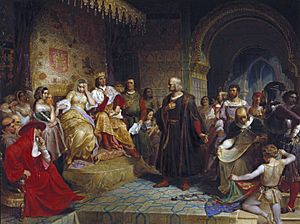
Columbus and his brothers were jailed for six weeks. Then King Ferdinand ordered them released. On December 12, 1500, the king and queen called the Columbus brothers to their palace in Granada. Columbus's chains were removed, but he wore short sleeves so the marks on his skin could be seen. At the palace, the royal couple listened to the brothers. Columbus cried as he admitted his mistakes and asked for forgiveness. They were given their freedom back. On September 3, 1501, Columbus's role as governor officially ended. Nicolás de Ovando became the new governor. Columbus kept the titles of admiral and viceroy. A royal order on September 27 told Bobadilla to return Columbus's belongings.
Columbus's Fourth Voyage (1502–1504)
After much convincing, the monarchs agreed to pay for Columbus's fourth voyage. This was his last chance to prove himself. Columbus wanted to find the Strait of Malacca to the Indian Ocean. On March 14, 1502, Columbus started his fourth voyage with 147 men. He had strict orders not to stop at Hispaniola. He was only to search for a western passage to the Indian Ocean. He left Cádiz on May 9, 1502, with his flagship and three other ships.
After crossing the Atlantic in a quick twenty days, they landed at Martinique on June 15. Columbus expected a hurricane was coming. He also had a ship that needed to be replaced. So, he headed to Hispaniola, even though he was told not to land there. He arrived at Santo Domingo on June 29. But he was not allowed to enter the port. The new governor refused to listen to his warning about a storm. While Columbus's ships found shelter, Governor Bobadilla left with a convoy of 30 other ships. Bobadilla's ship had over $10 million worth of Columbus's gold. Columbus's own gold was on a fragile ship. The hurricane hit, sinking some ships in the harbor. Bobadilla's ship is thought to have sunk. About 20 other ships sank in the Atlantic, and about 500 people drowned. Only one of Columbus's ships made it to Spain.
After the hurricane, Columbus regrouped with his men. After a short stop in Jamaica and off the coast of Cuba for supplies, he sailed to modern Central America. He arrived at Guanaja in Honduras on July 30, 1502. Here, his brother Bartholomew found native merchants, possibly Mayans, in a large canoe filled with goods. The natives introduced Columbus to cacao. On August 14, Columbus landed on the mainland of the Americas near Trujillo, Honduras. He spent two months exploring the coasts of Honduras, Nicaragua, and Costa Rica. He was looking for the passage to the Indian Ocean. He arrived in Almirante Bay, Panama, on October 16.
In mid-November, some natives told Columbus about a place called Ciguare. They said it was "just nine days' journey by land to the west." They said it had "gold without limit" and people who "know of pepper" and "do business in fairs and markets." Columbus later wrote that the natives said "the sea encompasses Ciguare and ... it is a journey of ten days to the Ganges River." This might mean Columbus realized he had found a new continent, different from Asia.
On December 5, 1502, Columbus and his crew faced a terrible storm. Columbus wrote in his journal:
For nine days I was as one lost, without hope of life. Eyes never beheld the sea so angry, so high, so covered with foam. The wind not only prevented our progress, but offered no opportunity to run behind any headland for shelter; hence we were forced to keep out in this bloody ocean, seething like a pot on a hot fire. Never did the sky look more terrible; for one whole day and night it blazed like a furnace, and the lightning broke with such violence that each time I wondered if it had carried off my spars and sails; the flashes came with such fury and frightfulness that we all thought that the ship would be blasted. All this time the water never ceased to fall from the sky; I do not say it rained, for it was like another deluge. The men were so worn out that they longed for death to end their dreadful suffering.
In Panamá, he learned from the Ngobe people about gold and a strait to another ocean. He set up a small base at the mouth of the Belén River in January 1503. By April 6, his men captured the local tribe leader, El Quibían. El Quibían escaped and returned with an army to attack the Spanish. They damaged some ships, and one had to be left behind. Columbus left for Hispaniola on April 16. On May 10, he saw the Cayman Islands. He named them Las Tortugas because of the many sea turtles there. His ships were damaged again in a storm off Cuba. Unable to travel further, the ships were beached in St. Ann's Bay, Jamaica, on June 25.
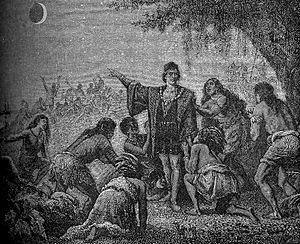
Columbus and his men were stuck on Jamaica for a year. A Spaniard, Diego Mendez, and some natives paddled a canoe to get help from Hispaniola. The island's governor, Nicolás de Ovando, did not like Columbus. He tried to stop efforts to rescue Columbus and his men. Meanwhile, Columbus had to impress the natives to avoid being attacked. He did this by correctly predicting a lunar eclipse for February 29, 1504. He used an astronomy book to do this.
In May 1504, a fight happened between men loyal to Columbus and those loyal to the Porras brothers. Help finally arrived from Governor Ovando on June 29. A ship sent by Diego Méndez appeared. At this time, 110 of the original 147 men who sailed with Columbus were still alive. Because of strong winds, it took the ship 45 days to reach Hispaniola. This was a trip Diego Méndez had made in four days by canoe.
About 38 of the 110 surviving men decided to stay in Hispaniola instead of returning to Spain. On September 11, 1504, Christopher Columbus and his son Fernando sailed from Hispaniola to Spain. They arrived in Sanlúcar de Barrameda on November 7 and then traveled to Seville.
Columbus's Legacy
News of Columbus's first voyage led to many other explorations by European countries. They wanted to gain wealth from trade and colonization. This started a big exchange of living things and goods across the Atlantic. These events are sometimes seen as the beginning of the modern era.
When he first landed, Columbus thought about forcing the native people to work. When he returned, he told everyone that the natives seemed ready to become Christians. Columbus's second voyage included the first major fight between Europeans and Native Americans in 500 years. In 1503, the Spanish monarchs created settlements to relocate and use the native people for labor.
The Age of Discovery began in the 15th century. Europeans explored the world by sea, looking for valuable goods, people to force into labor, and new trading places. Gold, silver, and spices were the most desired goods. To avoid conflict, the Catholic monarchies of Spain and Portugal needed to divide their influence over the new lands. This was settled by the Pope in 1494 with the Treaty of Tordesillas. This treaty aimed to divide the world between the two powers. Portugal received everything east of a certain line. Spain received everything west of this line. This western territory was mostly unknown and turned out to be the vast majority of the Americas and the islands of the Pacific Ocean. In 1500, the Portuguese navigator Pedro Álvares Cabral arrived at the eastern coast of South America, on the Portuguese side of the line. This led to Portugal settling what is now Brazil.
In 1499, the Italian explorer Amerigo Vespucci joined a trip to the western world. Columbus had called the West Indies the Indias Occidentales ('West Indies') in 1502. He called them "unknown to all the world." Later that year, he gathered information from natives in Central America. This information seemed to show that he realized he had found a new land. Vespucci, who first thought Columbus had reached Asia, suggested in a 1503 letter that he had known for two years that these lands were a new continent. In 1507, a year after Columbus died, the New World was named "America" on a map by a German mapmaker, Martin Waldseemüller.
On September 25, 1513, the Spanish explorer Vasco Núñez de Balboa traveled overland. He became the first European to see the Pacific Ocean from the Americas. He called it the "South Sea." Later, on October 29, 1520, Magellan's expedition found the first sea passage from the Atlantic to the Pacific. This was at the southern end of what is now Chile, called the Strait of Magellan. His fleet then sailed around the whole Earth.
In the Americas, the Spanish found large and populated empires. Small groups of Spanish explorers, with help from large armies of native groups, managed to conquer these states. The most famous were the Aztec Empire in modern Mexico (conquered in 1521) and the Inca Empire in modern Peru (conquered in 1532). During this time, European diseases like smallpox greatly harmed the native populations. Once Spain had control, they focused on taking and exporting gold and silver.
|


